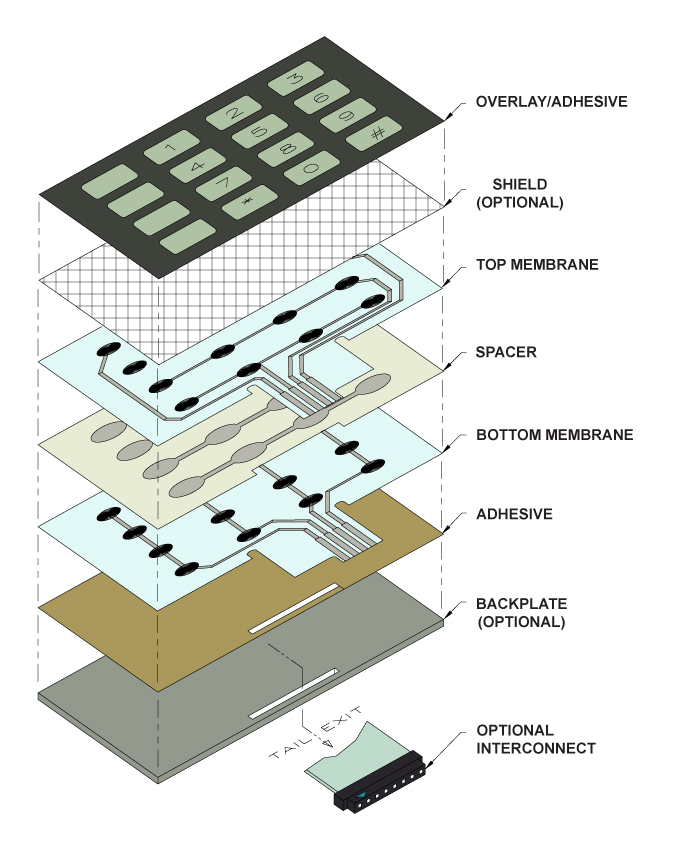Membrane Layer Change Innovation: The Secret to Reputable and Cost-Effective Interfaces
Membrane switch innovation has actually become an essential part in the style of user interfaces, offering both reliability and cost-effectiveness across a varied series of applications. Its durable building guarantees resistance to environmental obstacles, while the adaptability in design enables customized options that satisfy certain sector requirements. As we discover the multifaceted advantages of membrane layer buttons, their potential for technology questions regarding future applications and advancing fads. What does the next phase hold for this technology in a progressively electronic landscape?
Comprehending Membrane Switch Innovation
Membrane button innovation is a commonly made use of user interface service in different electronic gadgets, using a smooth mix of performance and design. This innovation incorporates numerous layers of materials, normally containing a graphic overlay, spacer layer, and a circuit layer. The graphic overlay shows the user interface aspects, while the spacer layer separates the circuit layer from the overlay until a customer turns on a switch.
When pressure is related to the overlay, the circuit layer finishes the electrical circuit, sending out a signal to the tool. This device allows for different setups, including tactile feedback and backlighting alternatives, improving customer communication. Membrane buttons are usually manufactured making use of resilient products such as polyester or polycarbonate, making certain long life and resistance to environmental factors like moisture and dirt.
The versatility of membrane switches over enables their application in varied sectors, including medical tools, consumer electronic devices, and commercial controls. Their compact style enables integration into space-constrained environments, providing a reliable interface without endangering aesthetic charm. Recognizing the intricacies of membrane switch modern technology is necessary for suppliers and designers seeking to create trusted and effective human-machine interfaces.
Secret Advantages of Membrane Layer Switches
While various user interface services exist, membrane layer switches over offer unique advantages that make them a favored option in numerous applications. One of the key advantages is their longevity; membrane layer switches are developed to hold up against harsh environmental conditions, including wetness, dirt, and temperature level fluctuations, guaranteeing lasting efficiency. This durability substantially minimizes the need for regular replacements, thus lowering total maintenance expenses.

Furthermore, membrane layer switches are light-weight and portable, making them appropriate for applications where area is limited. Their inconspicuous layout adds to a smooth look without jeopardizing capability.
Cost-effectiveness is likewise a noteworthy advantage, as the production process for membrane changes has a tendency to be less costly More Bonuses contrasted to standard mechanical buttons. This cost, combined with their dependability and ease of setup, placements membrane switches as a functional option for a large range of markets seeking reliable and effective individual interfaces.
Applications Throughout Numerous Industries
Exactly how do membrane layer buttons adjust to the varied needs of different sectors? Membrane layer button technology is increasingly acknowledged for its adaptability, making it suitable for a vast array of applications throughout several markets. In the medical area, membrane layer buttons are used in analysis equipment and patient tracking tools, where their resilience and ease of cleaning are vital for maintaining hygiene criteria. The automobile market employs these buttons in control panels and control board, offering a streamlined visual while making sure user-friendly operation.
In consumer electronic devices, membrane buttons supply a small solution for remotes and home devices, improving customer experience through instinctive design. Furthermore, the industrial market leverages membrane layer buttons for machinery control board, taking advantage of their resistance to rough environments, such as moisture and dirt.
Army and aerospace applications likewise utilize membrane switches for their dependability and capability to hold up against check this extreme conditions, making sure functional efficiency in critical scenarios. The food and drink sector adopts these buttons for automated systems, where cleanliness and simplicity of operation are paramount (membrane switch). Inevitably, membrane layer switches are customized to satisfy the special needs of each sector, showing their crucial function in contemporary innovation interfaces
Layout and Modification Alternatives

In the realm of membrane layer switch innovation, design and customization alternatives play an essential function in boosting functionality and individual communication. These switches can be tailored to meet details functional needs and visual preferences, making them flexible parts in numerous applications.
One of the primary modification choices is the design of the button itself, which can be designed to accommodate special customer interfaces and ergonomic factors to consider. By readjusting the shape, dimension, and arrangement of buttons, producers can develop instinctive layouts that promote simplicity of use. Furthermore, the incorporation of different colors and visuals overlays permits branding and improved presence, making certain that users can quickly recognize features.
Furthermore, membrane layer switches can be engineered with different responsive responses devices, such as increased buttons or distinct clicks, to improve the customer experience. Different products can likewise be chosen for durability and environmental resistance, addressing variables such as dampness, temperature changes, and chemical exposure.
Eventually, the comprehensive style and modification alternatives available in membrane layer switch technology equip services to produce tailored solutions that not only meet useful needs however additionally straighten with their branding and functional requirements.

Future Trends in Membrane Layer Switches
As membrane layer switch innovation remains to evolve, future patterns are increasingly focused on enhancing individual experience and incorporating advanced functionalities. One Discover More Here significant fad is the combination of touch-sensitive and capacitive technologies into typical membrane layer switches. This development enables more instinctive interface, providing responsive responses while keeping a smooth layout.
One more emerging fad is making use of eco pleasant products, driven by the expanding need for lasting production methods. Suppliers are looking for to minimize their carbon footprint by using recyclable substratums and low-impact inks, aligning with international sustainability objectives.
In addition, the rise of the Internet of Things (IoT) is triggering the unification of smart attributes into membrane layer switches. Enhanced connectivity alternatives will certainly allow tools to communicate with each various other, enabling smooth combination into broader systems.
Additionally, advancements in printing technologies, such as digital printing, are permitting greater design flexibility and personalization. This enables producers to create complex styles and vibrant colors cost-effectively.

Verdict
In final thought, membrane layer switch modern technology represents an essential innovation in user interface design, using considerable benefits in toughness, customization, and cost-effectiveness. As innovations proceed to emerge, especially in touch-sensitive interfaces and sustainable products, the potential for membrane switches over to improve user experience and capability continues to be promising.
 Mason Reese Then & Now!
Mason Reese Then & Now! Shannon Elizabeth Then & Now!
Shannon Elizabeth Then & Now! Tina Louise Then & Now!
Tina Louise Then & Now! Dolly Parton Then & Now!
Dolly Parton Then & Now! Meadow Walker Then & Now!
Meadow Walker Then & Now!